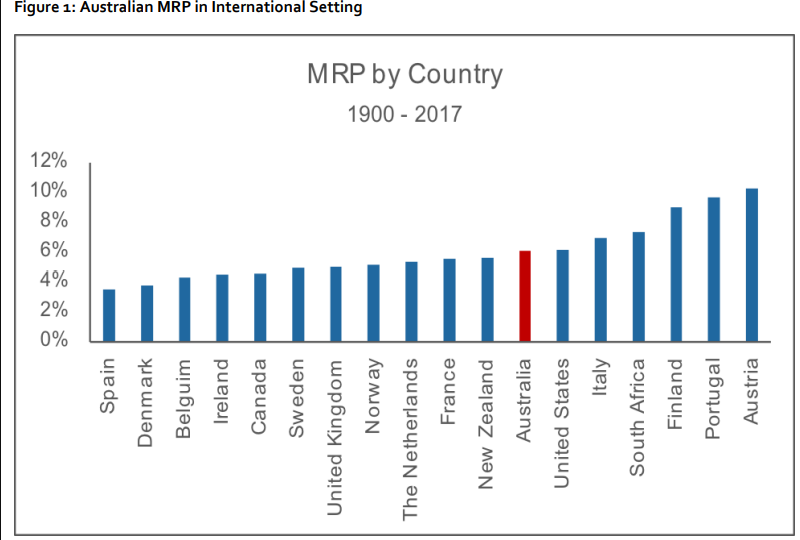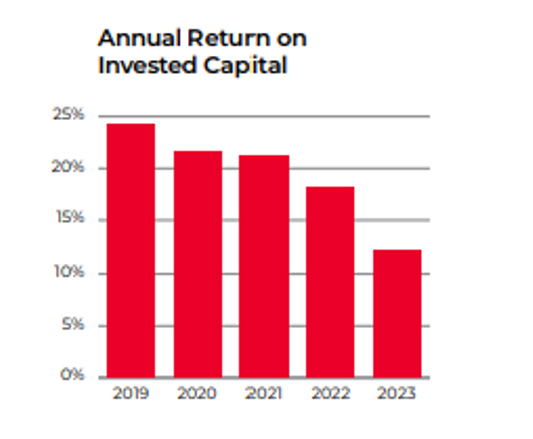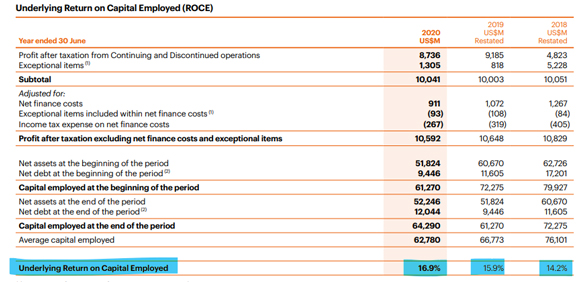Are the biggest ASX stocks overvalued?
Are ASX stocks expensive?
One way to assess this is via the spread between the risk-free rate (the rate investors can get on ultra-safe assets like government bonds) and the earnings yield on equities.
In Australia, the common proxy for the risk-free rate is the yield on 10-year government bonds.
Currently, the 10-year bond yield is 4.32%.
Given the ASX 200 has an earnings yield of ~6.76%, the Aussie stock market’s equity risk premium is 2.44%.
Not much compensation for the added risk of investing in stocks as opposed to the nearly riskless government bonds.
Especially when you consider some research suggesting Australia’s historic market risk premium is around 5.1%

In other words, Aussie stocks are pretty expensive.
But can we measure this another way?
What if we took the biggest ASX stocks and valued them? Would our estimates of intrinsic worth overvalue or undervalue the companies?
Let’s find out.
Valuing the biggest stocks on the ASX
Let’s look at the three biggest stocks on the ASX 200 by market capitalisation and then value them using the Return on Equity (ROE) stock valuation formula.
This is not a very scientific approach … but I hope it will be fun and illustrative anyway.
If you haven’t read Greg’s Canavan's book or watched the recent What’s Not Priced In episode on stock valuation, here’s the ROE formula:

Currently, the three largest ASX companies by market cap are BHP, Commonwealth Bank, and CSL.

Let’s see if the current prices the ASX’s biggest stocks trade at are justified.
Commonwealth Bank valuation
Let’s first turn to Commonwealth Bank of Australia [ASX:CBA].
Both Greg and I have estimated CBA’s intrinsic value in recent weeks.
Greg did so during the stock valuation special on What’s Not Priced In.
And I did it when demonstrating the usefulness of the dividend discount model.
Each time, our intrinsic value estimates showed the bank was overvalued.
This hasn’t changed in the weeks since.
On a FY24 forecast ROE of 13.2% and a payout ratio of ~75%, we get reinvested ROE of 3.3%.
Given a discount rate of 8%, CBA’s equity multiple comes in at 1.92. With a FY24 book value per share of $43.6, Commonwealth Bank’s estimated intrinsic value is $83.7.
Well below the bank’s current price of around $100 a share.
Progress report: one stock appraised, one stock overvalued.
CSL valuation
Let’s now move on to biotech giant CSL, who released its FY23 results this week.
FY23 revenue rose strongly, up 26%, to US$13.3 billion but net profit after tax fell 3% to US$2.19 billion.
CSL is a behemoth in its field, with entrenched competitive advantages.
But with the FY23 results now out, CSL is trading on a trailing P/E of nearly 40.
Is the multiple justified?
Let’s run the numbers.
CSL’s FY24 ROE is forecast at 17.4% on a payout ratio of 45%, meaning its reinvested ROE is 9.6%.
So, using an 8% discount rate, we get an equity multiple estimate of 3.59.
Given CSL’s FY24 book value per share is about $56.9, we get an intrinsic value estimate of about $204.3 a share.
That implies the biotech giant is over 20% overvalued.
Why the discrepancy?
I have a hunch it has something to do with CSL’s historic ROE figures. The market may be giving more weight to CSL’s past than its present.
If we use the Return on Invested Capital (ROIC) as a proxy, we can see that CSL’s profitability has been trending down in recent years.
Is the market assuming CSL's profitability will improve in the coming years?

Progress report: two stocks appraised, two stocks overvalued.
BHP valuation
BHP is a special case and gave me plenty of trouble.
I went through a few looseleaf sheets rerunning the calculations as the results were bewildering.
Let me show you why.
The mining giant’s FY24 ROE is forecast at a chunky 27%. Let’s assume a payout ratio of 70%, meaning BHP’s reinvested ROE is ~8.1%.
Using a discount rate of 8%, we get an equity multiple estimate of 5.78.
On a forecasted FY24 book value per share of US$9.17, we get a crazy intrinsic value of US$53 a share.
At prevailing exchange rates, that’s around AU$82 a share, nearly a 100% premium to the current price…
What the #@$! is going on here?!
The ROE forecasts are too wacky.
According to historical data compiled by Market Index, BHP’s ROE over the last decade (beginning 2013) was 16.7%, 17%, 11.4%, 16%, 12.4%, 17.7%, 20.4%, 19.1%, 33.4%, and 47.5%.
Over this span, the miner’s ROE averaged 21.2%.
But the last few years are outliers.
A pandemic, disrupted supply chains, Russia’s invasion of Ukraine, and a surge in global inflation sent key commodities surging.
Just look at BHP’s FY22 return on capital employed (ROCE) for iron ore and coal.

Yet in FY20, BHP's group ROCE was 16.9%.

So, if we exclude the last two years, BHP’s average ROE drops to 16.3%.
Let’s bump that up to 17%.
Now we get an intrinsic value of US$26 a share, or AU$40.
That’s about 10% overvalued, given the current price.
Progress report: three stocks appraised, all three overvalued.
Clearly, this is not a very rigorous approach, but I hope it was informative nonetheless.
The exercise suggests the top end of town offers little in the way of reward given the risks.
It seems value resides elsewhere.
4 topics
3 stocks mentioned
.png)
.png)